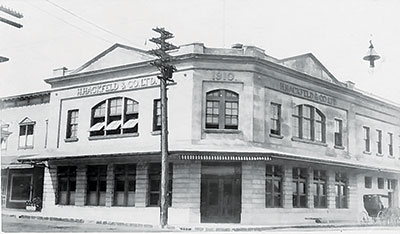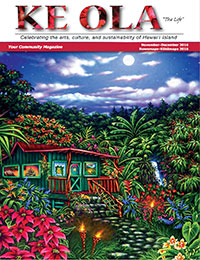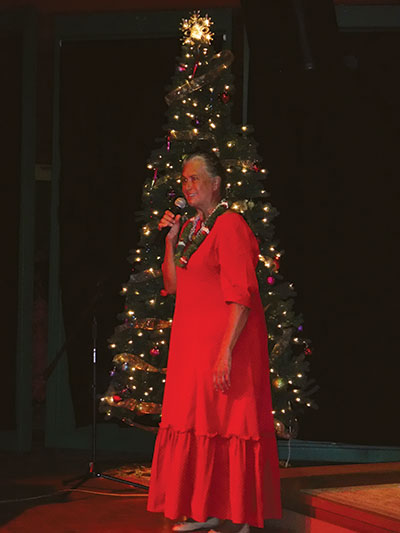A Historic Family Business and Building: How the Koehnen’s Family Roots Correspond with a Historic Hilo Building
 By Megan Moseley
By Megan Moseley
On the bustling street of downtown Hilo’s bayfront, visitors and residents alike often stroll by a bright green building that hugs the corner of Kamehameha Avenue and Waiānuenue Street.
To residents, it’s called the “old Koehnen Building.” The numbers “1910” protrude from the upper part of the facility in bright white lettering, alluding to its antiquity.
These days, most people are drawn to this iconic location for the Mokupāpapa Discovery Center (MDC), an interactive museum honoring Papahānaumokuākea Marine National Monument, or to visit one of the other stores located nearby.
What some may not know is this edifice significantly symbolizes one family’s history. Until recently, 92-year-old Fred J. Koehnen and his family owned the 106-year-old building when he sold it to Giuseppe “Joe” Mamone of G.E.K. Mamone & Sons LLC, a former tenant of Fred’s. The transfer marks the end of an era for Hilo and the Koehnens.
Building “Anew”
A lot has changed since brother-in-law Carl E. Rohner and Fred bought the building for F. Koehnen, Ltd.

For starters, the family’s well-known furniture store no longer occupies the space. In its place is the MDC, that acts as an arena for excited children eager to play with one of the many interactive displays and visitors looking to learn more about the National Monument. (see story on page 26)
The MDC took over the facility in 2014, and Fred has said on multiple occasions that the center was a “match made in heaven.” Fred was quoted in multiple newspapers describing his enthusiasm for the MDC, saying it was a perfect way to give back to this small island community.
A few doors down is the newest resident, The Locavore Store. Owners Catarina and Arthur Zaragoza-Dodge became tenants when they decided to move locations from Pāhoa during the June 27, 2014 lava flow.
Catarina says what impresses her the most about the building is its historic elements.
“The big staircase we have in there was originally built by the same guy who built the staircases on the Titanic, which is crazy!” she says joyfully.
Next to The Locavore Store is a jewelry shop called Anela’s Jade and in the back is where the new owner holds his flooring samples. Joe says he used to sell his floors out of the Koehnen’s old furniture store and moved in the back when the store shut down. After purchasing the building, he says he really doesn’t have any plans to change the place.
“I’m just going to leave it as it is for now,” he says.
Like everyone else who knows the Koehnens, Joe describes them as “a really good family.”
Arguably, nobody in the Koehnen Building knows this family better than Kellie DeRego, who has worked for the Koehnens since she was 17, 38 years ago.
“They’ve known me from my high school days to right when I got married to when I had my daughter. When she was a baby I would bring her to work with me and she would be in my desk drawer,” she jokes. “They’re wonderful to me. I love them.”
So how is it that this adored family landed in Hilo and how is it that the Koehnen Building came to be?
If Walls Could Talk
If the walls of the Koehnen Building could talk, it would be a story of how one German immigrant made his way across the globe only to find a home in the middle of the Pacific.
Fred’s father, Freiderich “Fritz” Wilhelm Koehnen, was born in Bremen, Germany. He was an only child who, according to Fred, had a somewhat difficult upbringing that inspired him to search for greener pastures.
So, in 1908, at the ripe age of 19, Fritz traveled across the Atlantic Ocean to Ellis Island. From there, he journeyed through the mainland by railroad and finally ended up in Hawai‘i by ship. He landed in Hilo and went to work as a bookkeeper and general clerk for H. Hackfeld & Co., one of the main suppliers and owners of sugar plantations at the time.
Owner Heinrich Hackfeld, a German sea captain, eventually acquired the entire block of land on the bayfront through to Shipman Street (located behind the Koehnen Building). He decided to build what would come to be known as the “Hackfeld Building,” and many years later would become the Koehnen Building.
In 1910, the Hackfeld Building came to life. It was built by hand with a concrete basement and concrete perimeter walls. According to a document provided by Fred, the walls consist of 12-15 inches of concrete reinforced with embedded steel rails that were two stories high. Some of the floors were made from ‘ōhi‘a.
Koa wainscoting and a grand koa staircase were later constructed. The building was located across from the main Hilo railroad that ran all the way to Volcano and up the Hāmākua Coast. One could only imagine what Hilo must have looked like during those days.
After only two years in Hilo, Fred’s father Fritz had to move back to Germany to serve a mandatory year of service in the German army. He loved Hawai‘i and didn’t want to leave, but as fate would have it, all was not lost. While back in Germany, Fritz ended up meeting the love of his life.
The story of how Fred’s mother, Katharine “Kate” Bocker, and his father met could be a romantic classic on its own. Their paths crossed while taking ballroom dancing classes, they fell in love, and got engaged. They planned to move back to Hawai‘i and get married. Fritz left for Hilo in hopes of bringing the future Mrs. Koehnen over as soon as possible. However, with the onset of World War I, it would be seven years before they could say their vows.
Katharine stayed in Germany until 1921, when she could finally make her way to Hawai‘i. Knowing almost no English, she also traveled across the ocean to Ellis Island, and then made her way across the United States mainland by train before making it to Honolulu by ship. Fred’s father was waiting for her upon arrival and they got married that day.
“When one considers the long distance engagement that extended over seven years with only spotty letters over that span, it speaks of the now forgotten culture of a past era when commitment was truly commitment,” says Fred.
As History Would Have It
Prior to Katharine’s arrival, Congress had enacted the “Trading with the Enemy Act” and all German-owned assets in America were confiscated, including H. Hackfeld & Company where Fred’s father worked.
The company was sold to a consortium of Honolulu businessmen who renamed it “American Factors,” later shortened to Amfac. Amfac became one of the notorious “Big Five,” the largest businesses in the Territory of Hawai‘i who were known for dominating politics and the economy during that time.
The trade of the company resulted in Fritz losing his job. Lucky for him, he had established relationships with other businessmen in Hilo and he was able to find work as a bookkeeper for several businesses in town, including the Hill Optical Company. The company was owned and operated by former politician and businessman W.H. “Doc” Hill.
Fritz continued to work with the Hill Optical Company throughout the 1920s, when Fred and his sister were born. By 1929, Fritz took over the company and created F. Koehnen, Ltd.
He transformed the business into a store that would sell home amenities such as fine china, crystal, and eventually furniture. They operated out of a building on Kamehameha Avenue and the business continued to grow during World War II.
Time marched on and Fred ended up joining the military while his sister married army officer Carl Rohner. Carl later joined forces with Fred and his father to help manage the business. They continued to operate out of the same location until the tragic 1946 tsunami hit the island.
When the tsunami struck it destroyed much of downtown Hilo and many of its buildings. While the Koehnens’ business survived relatively unscathed, other businesses suffered greatly. The Hackfeld Building also survived the catastrophic event, however, the wave wiped out its lumberyard and building materials facility. That was enough to cause Amfac to move, leaving the Hackfeld Building up for grabs.
Coming Full Circle
By 1947, Fred joined the family business to help relieve his father who was suffering from some health problems. His sister, Helie H. Rohner, remained as part of the overall management. It was truly a family business.
Less than a decade later, in 1956, Fred and his brother-in-law decided to buy the old Amfac building. Thus completed the story of how the Koehnen Building came to be.
“The building went full circle,” he says.
For years they sold tableware, giftware, and furniture in what is now the Mokupāpapa Discovery Center. The business survived another tsunami in 1960. This time they weren’t as lucky.
Fred jokes that “the worst part was cleaning up the mud, debris, fish, and eels left behind!”
In 1964, Fred left the family business, handing it over to his sister and her husband.
The family name grew in recognition and they eventually branched out to the west side of the island. As the years passed, things changed. There was no family left who were interested in continuing the business, so the shop “reluctantly closed.” The Kona branch shut down in 2009 and the Hilo store closed its door at the end of 2012.
In an article about the building, Fred reflected on the moment: “Thus ended the saga of over 83 successful years of retailing on the Big Island.”
One can only imagine the nostalgia Fred and his family has for the building. To those passing by, it may just look like another old Hilo structure, however, to the Koehnens it will always be so much more.
It will always be, in one way or another, home. ❖
Contact writer Megan Moseley: meganr.moseley@gmail.com


